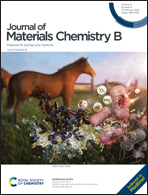Complying with the physiological functions of Golgi apparatus for secretory exocytosis facilitated oral absorption of protein drugs†
Abstract
Intestinal epithelial cells are the primary biological barriers for orally administrated nano-formulations and the delivered protein drugs. Thereinto, besides the cellular uptake, intracellular trafficking pathway and the related exocytosis are of great importance to the trans-epithelial transport of drug-loaded NPs. Herein, inspired by the physiological functions of Golgi apparatus for secreting proteins out of cells, Golgi localization-related amino acid L-cysteine (Cys) was modified on the surface of NPs to see whether and how this modification could guide the Golgi pathway-related transport and facilitate the exocytosis of drug-loaded NPs. Meanwhile, cell-penetrating peptide octa-arginine (R8) was co-modified to increase the cellular uptake. The proportion of R8 and Cys modification was explored to get the best effect of endocytosis and exocytosis of NPs. As a result, 25%R8 + 75%Cys NPs with most Cys modification showed efficient transcytosis with the highest transcytosis/endocytosis ratio (0.87). Interestingly, exocytosis mechanism studies indicated that they trafficked through the Golgi secretory pathway and bypassed lysosomes due to Cys modification. The detailed Golgi position mechanism studies further suggested that the thiol group from Cys was important for mediating Golgi transport. In particular, competitive inhibition studies demonstrated that Cys-modified NPs were more conducive to their exocytosis after being transported through the Golgi secretory pathway. We proved that cargos transported via Golgi apparatus tended to be trafficked out of the cells and avoid degradation, which contributed to the transcytosis of 25%R8 + 75%Cys NPs in vitro. Inspiringly, compared with unmodified NPs, 25%R8 + 75%Cys NPs also exhibited promoted intestinal penetration and oral absorption in vivo. Oral delivery of insulin-loaded 25%R8 + 75%Cys NPs showed stronger hypoglycemic effects in diabetic rats. In summary, this work provides a strategy for complying with the physiological functions of Golgi apparatus for secreting to facilitate the exocytosis of NPs, thus further improving the oral absorption of loaded protein drugs.



 Please wait while we load your content...
Please wait while we load your content...